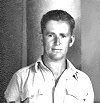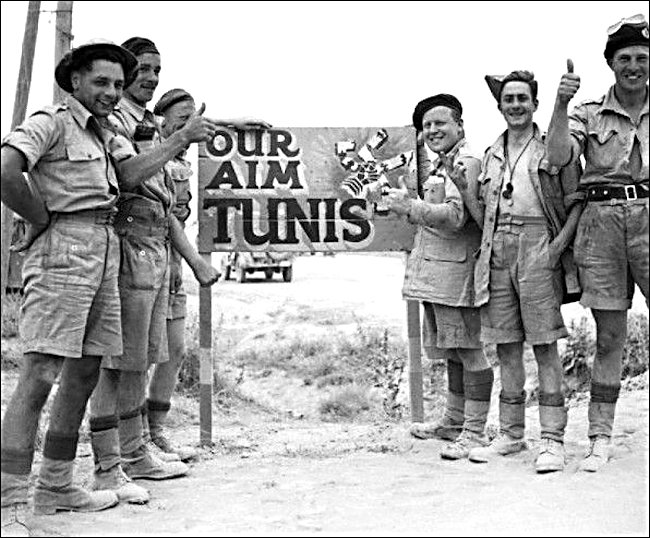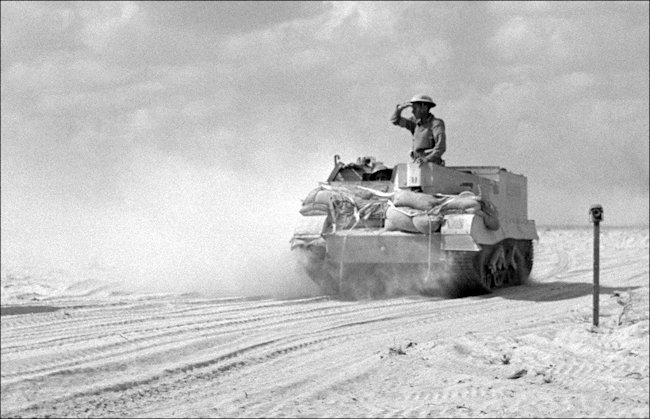2nd KRRC and the Battle for Tunisia February 1943
Len Moore fought with the 2nd Battalion Kings Royal Rifle Corps 2/KRRC across the deserts of North Africa during WW2 from 1941 to 1943. After the second Battle of El Alamein his unit chased Rommel's retreating Africa Korps Panzerarmee through Tunisia eventually capturing Tunis.

Len Moore 2nd Battalion Kings Royal Rifle Corps
The KRRC cross the Tunisian Frontier
On the 30th January 1943 B Company Kings Royal Rifle Corps returned from its patrol, which had reached the Tunisian frontier without incident.
On 8 February 1943, the 2nd Battalion moved forward again to the Tunisian border whence it launched A Company (Maj J. H. P. Curtis) with one troop each of 25-pounders, anti-tank guns and L.A.A. guns, and also a section of sappers. The Company was directed on to Foum Tatahouine, which formed the southern most outpost of the Mareth line.

A variety of British Soldiers next to a sign in Tunisia 1943
On the first day, the column heavily attacked by Me 109's and lost six trucks. Early next morning it was again attacked, and Maj Curtis takes up the story: We did not have long to wait before the first air attack materialized. Coming from the west a squadron of nine Me 109 G's, doubtless our adversaries of the previous day, spotted our vehicles and swung into position 'up-sun' to attack us. The Bofors guns started pumping out their clips of five shells but the enemy planes dipped their noses and dived straight at them.
Three bombs from the leading section of planes burst astride an Anti-Aircraft gun in the wadi and the gun stopped firing. Other bombs were dropping all over the area and a petrol lorry was hit and began to burn. The enemy squadron zoomed away and turned, still in their tight sections of three, and returned to the attack with their machine guns.
The next ten minutes was a confused jumble of impressions and sound: the roar of the fighter engines and the ugly ripping sound of their guns: the angry chatter of Bren and Vickers guns firing upwards : the occasional berbomp-berbomp-berbomp as one of the two remaining Bofors fired a despairing burst. Then suddenly all was quiet again as the enemy and made off undamaged towards their airfield to replenish ammunition. Reluctantly I got out of my slit-trench and went inspect the damage.
One 25-pounder gun-tower, one petrol truck, one ammunition truck, two 15-cwts., one Bofors gun knocked out and three men badly wounded was the result. Reluctantly I agreed with the AA troop commander that it was suicide for his guns to fire unless they were dug in and, since in any case we could not move further until the loads had been redistributed, I ordered the whole column to disperse still further and dig in properly.

The 2nd Battalion King's Royal Rifle Corps used Universal Bren-gun carriers in North Africa
To Brigade HQ I reported the attack and my intention to move on again An hour later the whole thing happened again. The same first swoop with bombs, the same repeated strafing attacks and the same apparent indifference to our retaliatory fire. Again more precious vehicles were destroyed but this time thanks to an hour's hard digging, not a man was hit. This time I reported that any further move in daylight was out of the question since only our wide dispersion and trenches were saving the column from being completely crippled. Bde HQ were not pleased and the Brigadier announced his intention of coming forward to see the situation for himself.
I was content; he had thirty miles to drive along desert tracks. About midday the Brigadier arrived at my HQ and I just had time to introduce him to my now spacious slit-trench when the third attack of the day started. From our point of view this was the best of the lot. There were no casualties among the men, only one truck was knocked out and this time we managed to inflict some damage on the enemy. One of the Vickers guns got in a good burst and the engine of one of the enemy fighters conked out right above us.
The pilot pulled back the cockpit cover, raised himself out of his seat, saw that he was only one hundred feet from the ground and changed his mind. The plane crash-landed a mile away and fifteen minutes later a jeep arrived at my HQ with the pilot, a typical blond young Nazi. I was delighted with the whole show because it convinced the Brigadier, more than I could have ever done, of the wisdom of not trying to move in daylight against such air superiority.
I promised that we would be at the pass, fifty miles away, which lead to Foum Tatahouine by first light the following morning and the Brigadier departed quite content, taking with him the captured pilot. The night march of forty-six miles took the column to within two miles of the pass through the hills surrounding the town: As it became light a low range of hills revealed themselves stretching right across our front and into these the track we had been following disappeared, a bare two thousand yards ahead. There was not a sign to show whether the enemy were waiting for us at the pass, so a carrier patrol was sent forward to investigate.